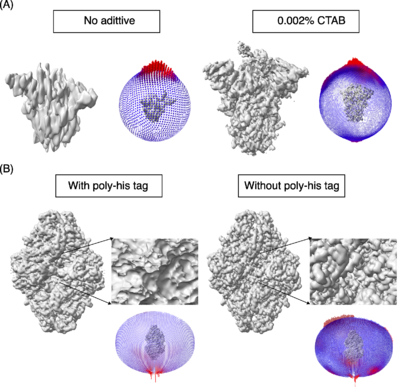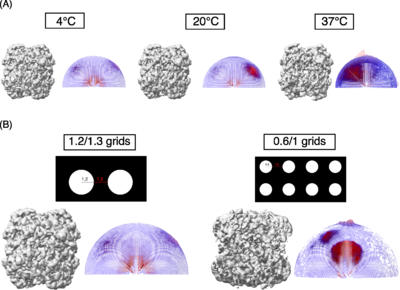Journal:Acta Cryst D:S2059798324005229
From Proteopedia
(Difference between revisions)

| Line 9: | Line 9: | ||
{{Clear}} | {{Clear}} | ||
'''Figure 1:''' The models used as reference are PDBs [[8h3d]] and [[6cvm]] for the spike protein and b-galactosidase respectively. A) Spike protein, SARS-COV-2. <scene name='10/1050322/Spike_no_additive/1'>Spike, no additive</scene> ([[8h3d]]). <scene name='10/1050322/Spike_with_ctab/1'>Spike with CTAB</scene> ([[8wzi]]). B) β-galactosidase. | '''Figure 1:''' The models used as reference are PDBs [[8h3d]] and [[6cvm]] for the spike protein and b-galactosidase respectively. A) Spike protein, SARS-COV-2. <scene name='10/1050322/Spike_no_additive/1'>Spike, no additive</scene> ([[8h3d]]). <scene name='10/1050322/Spike_with_ctab/1'>Spike with CTAB</scene> ([[8wzi]]). B) β-galactosidase. | ||
| + | |||
| + | There are multiple ways to address orientation bias including the use of support layers like carbon or graphene, tilting of the stage and more commonly, the use of surfactants or detergents as small molecule additives during grid preparation (Liu and Wang, 2023<ref name="Liu">PMID: 36563741</ref>). There are a number of macromolecules where surfactants have been used to overcome the preferred orientation problem. In this work, we asked if an informed decision regarding the grid freezing conditions can be made based on the properties of the macromolecule. | ||
| + | We studied macromolecules of different sizes and symmetries (125-440 kDa, C1 to D3) and tested a few commonly used surfactants to overcome the orientation bias and observed that many of these surfactants are beneficial. One such example is cationic surfactant CTAB, which causes changes in the orientation distribution of SARS-CoV-2 spike protein as shown in Figure1A. Further, we tested the effect of poly-histidine tag on orientation distribution of macromolecules. Figure 1B shows the impact of the N-terminal poly-his tag on orientation in the case of the E. coli β-galactosidase enzyme. We assessed the improvement in orientation distribution with different measures including the orientation distribution plot after 3D refinement (Scheres 2012<ref name="Scheres">PMID: 23000701</ref>), Efficiency of orientation distribution (Naydenova & Russo, 2017<ref name="Naydenova">PMID: 28931821</ref>), 3D-FSC (Tan ''et al.,'' 2018<ref name="Tan">PMID: 28671674</ref>) and the map vs model FSC curve. We also tested the effect of grid hole size and temperature during grid preparation on orientation bias demonstrated using human erythrocyte catalase as an example (Figure 2). | ||
[[Image:Figure2RR5238.png|left|thumb|400px]] | [[Image:Figure2RR5238.png|left|thumb|400px]] | ||
{{Clear}} | {{Clear}} | ||
| + | '''Figure 2:''' | ||
| - | + | In summary, physical and chemical factors affecting macromolecule behaviour on grids have been studied to overcome the preferred orientation problem (Figure 3). These findings lay a platform in achieving optimal freezing conditions for any given macromolecule in the future. | |
| - | + | ||
<b>References</b><br> | <b>References</b><br> | ||
Revision as of 06:53, 13 June 2024
| |||||||||||
This page complements a publication in scientific journals and is one of the Proteopedia's Interactive 3D Complement pages. For aditional details please see I3DC.


